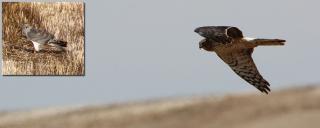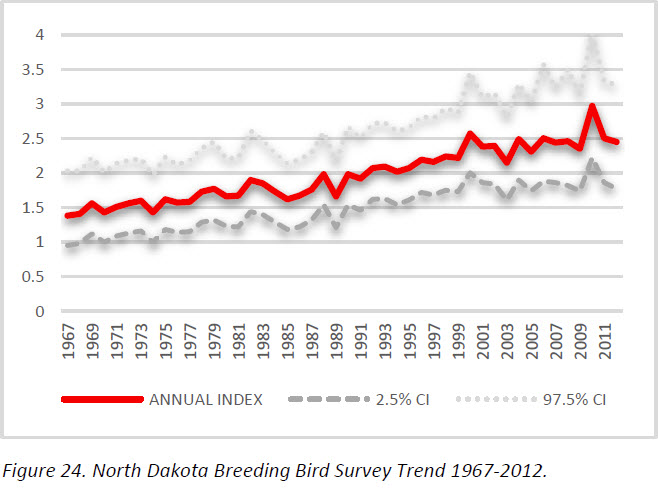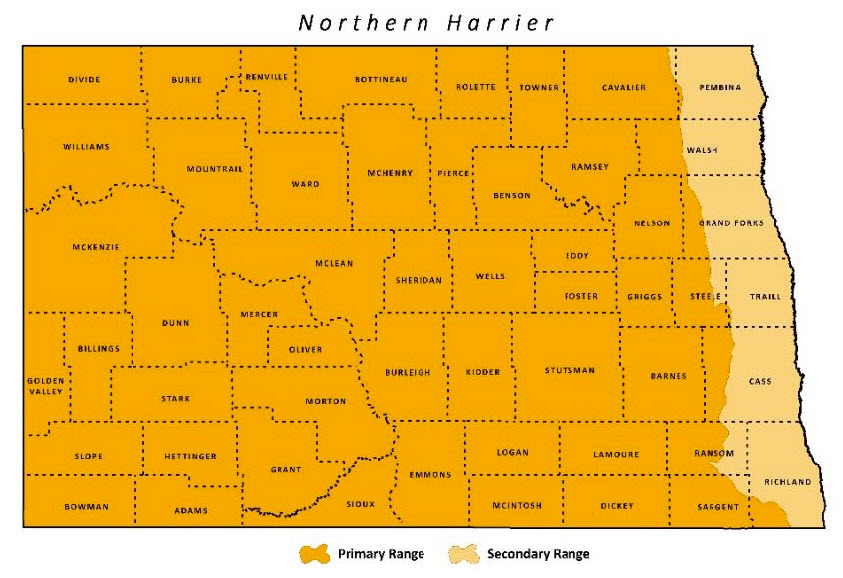

Northern Harrier
| Scientific Name | Circus cyaneus |
|---|---|
| General Description | L 18”, WS 43”, 15 oz. Both the pale gray male and slightly larger, brown female, sport an obvious white rump patch. |
| Status | Occurs in North Dakota from mid-February to mid-November. Peak breeding season early May to mid-July. |
| Abundance | Fairly common. |
| Primary Habitat | Open grasslands, wet meadows, marshes, and areas not heavily grazed. |
| Federal Status | Migratory Bird. |
| Reason for Designation | Northern Harriers are showing a slow rangewide decline but appear stable to increasing in North Dakota. However, loss of grassland and CRP in North Dakota may cause populations to decline. Partners in Flight (PIF) identifies the Northern Harrier as a Regional Concern and Stewardship Species and U.S.-Canada Stewardship Species. |
Locations and Conditions of Key Habitat
Preferred Habitat
Harriers use relatively open, undisturbed grasslands for nesting and wetlands of tall (>60 cm), dense vegetation with abundant residual vegetation for foraging. Native or tame vegetation in wet or dry grasslands, fresh to alkali wetlands, lightly grazed pastures, croplands, shrubby fields and fallow fields are utilized. Nest primarily on the ground in upland grassland in North Dakota, but have been observed using platforms of vegetation over water in other states. Nesting sites selected may be dictated by vole populations, their primary prey. Requires generally large tracts of contiguous grassland less than 100 ha, but can be found in grassland ranging from 8 to 120 ha. In North Dakota, Northern Harriers have been found to be positively associated with the amount of grassland in a landscape and negatively associated with amount of forest cover.
Key Areas and Conditions for Northern Harrier in North Dakota
No specific sites have been identified.
Problems Which May Affect this Species
Habitat
Conversion of grassland to cropland, energy development and urban expansion. Degradation of grasslands from invasive plants, woody encroachment, succession, and loss of diversity. Loss and degradation of wetlands. In hayfields, early cutting may destroy nests or young. Heavily and moderately grazed grassland or pastures are generally avoided by harriers.
Other Natural or Manmade Factors
Changes in the harrier population size may be closely related to vole populations. A decline in the population between 1947 and 1969 could be attributed to the use of DDT or DDE which caused the thinning of egg shells. The use of insecticides and rodenticides may reduce prey availability. Nest predation is a key source of mortality.
Research and Survey Efforts
Current Research or Surveys
- South Dakota State University (ND SWG T-36-R) is determining breeding ecology of Northern Harriers in south-central North Dakota.
Previous Research or Surveys
- Ducks Unlimited (ND SWG T-3-1 and T-8-R) determined demographic performance of prairie-nesting shorebirds and raptors in North Dakota. The project was initiated in 2004 and a final report provided in 2007. The highest reproductive success for Northern Harrier was in those areas with large amount of wetland area and native grassland, and wetland habitat that has dense nesting cover. Preserving large intact grassland/wetland landscapes are key to safeguarding populations of Northern Harrier (Stephens and Walker 2007).
Additional Research or Surveys Needed
Nothing identified at this time.
Population and Trend Estimates

- PIF Global Population Estimate: 1,400,000
- PIF North American Population Estimate: 700,000
- PIF North Dakota Population Estimate: 62,000
- North Dakota BBS Trend: see figure 24
- Survey-wide BBS Trend 1966-2012: -1.03
Management Recommendations
- Protect areas where complexes of high density wetlands and large blocks of grassland remain intact.
- Continue to promote reenrollment of the Conservation Reserve Program.
- Discourage wetland tillage and protect from drainage.
- Mow, burn, or graze grasslands every 2-5 years to maintain tall, dense, upland vegetation.
- Avoid disturbing nesting areas from April through July.
- Minimize human disturbance near nests.
- Do not use chemical pesticides where harriers occur.
Monitoring Plans
According to the Partners in Flight Landbird Conservation Plan, long-term population trend monitoring such as the Breeding Bird Survey is inadequate in the northern range for this species. Monitoring plans should follow recommendations of the North American Bird Conservation Initiative ‘Opportunities for Improving Avian Monitoring’.
2005-2015 Progress
The Northern Harrier remains a Level II Species of Conservation Priority. Several State Wildlife Grant Projects (T2-9-R, T2-11-HM, T-18-R, T-21-D, T-22-HM, T-23-HM, T-25-HM, T-27-HM, T-37-D) have contributed to habitat enhancement of wetlands and grasslands for Northern Harrier and other wetland/grassland dependent birds.

Note: A listing of works consulted when compiling the information on this page may be found in the 2015 State Wildlife Action Plan.
